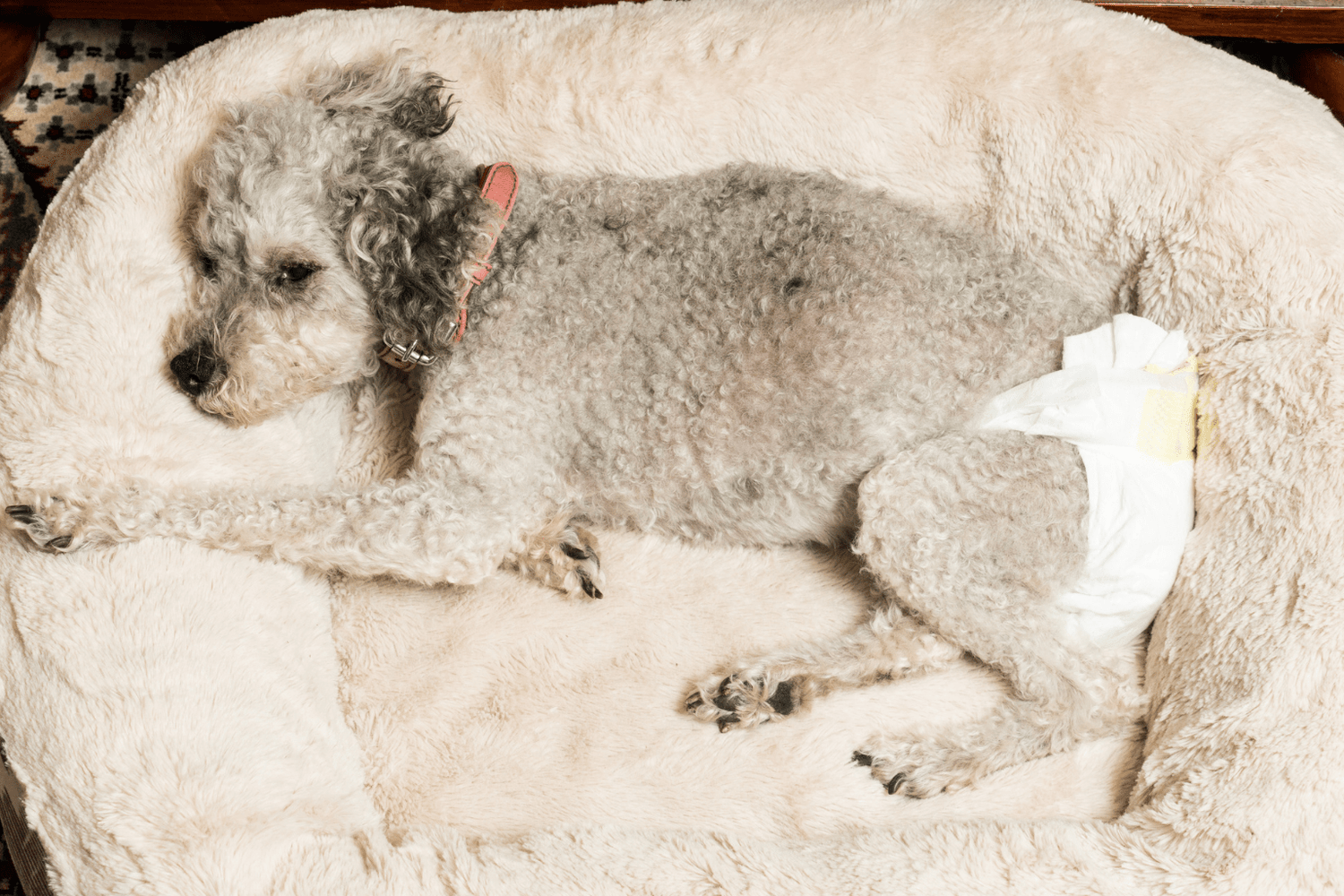Key Takeaways
- Dog diapers are designed with tail openings to effectively contain accidents and support housetraining.
- They are available in both disposable and reusable options to suit different needs.
- Specific diaper styles cater to male dogs (belly bands) and female dogs (full coverage).
- Dog diapers help keep senior or recovering pets comfortable and clean.
- Using dog diapers is not a replacement for professional veterinary advice.
Table of Contents
Keeping Pets Happy, Clean, and Confident, Your Guide to the Best Dog Diapers
Why Real Pet Parents Choose Dog Diapers
Dog diapers serve as gentle support tools for pets facing temporary or ongoing challenges. They're not just about convenience, they preserve your dog's dignity while addressing real health and behavioral needs. Discover natural dog supplements & remedies for common dog health problems to further support your pet's overall well-being.
Urinary incontinence affects many aging pets due to weakened bladder muscles or hormonal changes. Post-surgery dogs often need temporary protection while healing. Heat cycles in unspayed females create mess and stress for the entire household. Dog UTI & Kidney + Incontinence Support can be a helpful addition for dogs experiencing urinary issues alongside diaper use.
Marking behaviors in male dogs can persist even with training, especially in multi-pet homes or during transitions. Puppies and newly adopted rescues benefit from diaper support during housetraining, reducing accidents without replacing proper training.
When Not to Use Dog Diapers
Avoid diapers during diarrhea or severe GI upset, they create hygiene risks and skin irritation. Never leave diapers on unsupervised dogs who might chew them, creating choking hazards.
Remember: diapers provide support while you work with your vet to address underlying causes. They're tools, not permanent solutions for medical conditions requiring treatment.
Our Community Stories
Rachel manages 30+ rescue animals and relies on quality diapers during intake periods. "The best dog diapers help new arrivals feel secure while we assess their needs," she shares. Gary's senior Lab now enjoys longer hikes thanks to confidence-boosting protection that prevents embarrassing accidents on trails.
Types of Dog Diapers (What Makes Each Style Work?)

Understanding diaper styles helps you match the right solution to your pet's anatomy and specific needs. Each design addresses different challenges with targeted coverage and security features.
Dog Diaper Styles, What Fits and How
Female dog diapers provide full coverage around the hindquarters with secure tail holes and leg wraps. They're essential for heat cycles and incontinence management. Male belly bands wrap around the midsection, targeting marking behaviors with easier application and removal.
Disposable versus reusable options offer different benefits: single-use convenience for travel and short-term needs, or washable cloth versions for daily use and cost savings. Modern designs feature breathable materials that prevent overheating while maintaining absorbency.
| Style | Best For | Coverage | Key Features |
|---|---|---|---|
| Female Diapers | Incontinence, heat cycles | Full hindquarter wrap | Tail hole, leg security |
| Male Belly Bands | Marking, light incontinence | Midsection only | Quick changes, targeted |
| Full Coverage | Heavy incontinence, post-surgery | Waist to tail | Maximum protection |
New Innovations for 2025
Recent advances include anti-bacterial technology in reusable pads and moisture-wicking outer shells that keep skin dry. Clip-on straps accommodate energetic pets who previously struggled with traditional closures, while improved sizing charts help pet parents achieve better fits from the start. WALK-EASY® Advanced Joint Support can also support mobility for dogs who need diapers due to joint stiffness or discomfort.
How to Measure and Choose the Perfect Dog Diaper
Proper fit prevents leaks, chafing, and discomfort. Most diaper problems stem from incorrect sizing rather than product quality, making accurate measurement your first priority.
Steps to Find Your Dog's Best Fit
Measure your dog's waist at the widest point, typically just in front of the hind legs. For female diapers, also measure the distance from the base of the tail to the lower belly for proper coverage length.
Account for coat thickness, fluffy dogs need larger sizes to account for their coat when the diaper is secured. Always check the manufacturer's sizing chart, as measurements can vary between brands.
Test the fit before committing, you should be able to slip two fingers comfortably under the diaper without it being loose enough to shift during movement. The leg openings should sit snugly against your dog's body without creating red marks or indentations in the fur.
Matching Diaper to Your Pet's Needs
Your dog's age, gender, and specific condition determine which diaper features matter most. Senior dogs with incontinence benefit from maximum absorbency and easy-change designs, while active puppies need secure closures that won't slip during play. Natural over-the-counter supplements for small, extra-small & toy dog breeds and puppies can further support the health of young or petite dogs who may need diapers during housetraining.
For female dogs in heat, choose full-coverage options with leak-proof barriers around the tail area. Male dogs with marking behaviors often do better with targeted belly bands that focus protection where it's needed most. Consider your lifestyle too, disposable options work well for travel and short-term needs, while washable diapers offer better value for daily, long-term use.
Troubleshooting Common Sizing Problems
Signs your diaper is too tight: Look for chafing, red marks on the skin, hair loss around closure areas, or your dog showing discomfort when moving. If you notice any of these signs, size up immediately to prevent skin irritation.
Signs your diaper is too loose: Frequent leaks, the diaper shifting position during normal activity, or gaps around the leg openings indicate you need a smaller size or different closure style. Some dogs with unique body shapes may need adjustable straps or custom-fit options.
4-Step Fix for Poor Fit:
- Re-measure your dog when they're standing and relaxed
- Check if weight changes have affected sizing needs
- Try a different closure style (velcro vs. snaps)
- Consider adjustable straps for active dogs who shift positions frequently
Using Dog Diapers, Step-by-Step Success
Proper application makes the difference between a comfortable, confident dog and one who spends their day trying to remove their diaper. The key is creating a positive experience from day one, so your pet associates diaper time with care and comfort rather than stress.
Most dogs adapt to wearing diapers within a week when introduced gradually with patience and positive reinforcement. Start with short wearing periods and gradually increase the time as your dog becomes more comfortable with the sensation. For more tips on keeping your dog happy and engaged, check out our guide to the best puppy dog toys.
How to Put On a Dog Diaper or Belly Band
For female diapers: Gently lift your dog's tail and insert it through the tail hole first. Bring the diaper up between the back legs, ensuring the absorbent pad sits properly against the body. Wrap the sides around your dog's waist and secure the closures, checking that leg openings aren't too tight.
For male belly bands: Position the band around your dog's midsection, covering the area where marking typically occurs. The absorbent pad should sit against the belly, with the band snug enough to stay in place but loose enough for comfortable breathing and movement.
Keep the process quick and calm, aim to complete application within three minutes to minimize stress. If your dog is anxious, have treats ready and offer praise throughout the process. For particularly active dogs, non-slip straps help keep everything in position during play and exercise.
Positive Training Techniques
Start by letting your dog sniff and investigate the diaper before putting it on. This simple step helps reduce anxiety about the new item. Begin with very brief wearing sessions, just 10-15 minutes, while offering treats and engaging in normal, enjoyable activities.
Gradually increase wearing time over the course of a week rather than expecting immediate all-day acceptance. Watch for signs of stress like excessive panting, scratching at the diaper, or withdrawal, and scale back if needed. Most dogs respond well when diaper time becomes associated with positive experiences like meals, gentle play, or relaxation time with their favorite person.
Common Challenges & Quick Fixes
Diaper chewing or removal attempts usually indicate fit issues or boredom. First, double-check that the diaper isn't too tight or causing discomfort. Redirect chewing behavior with appropriate toys or activities, and consider non-slip straps for dogs who manage to wiggle out of standard closures.
Persistent leaks often point to sizing problems rather than product failure. Re-evaluate the fit around leg openings and waist, and ensure you're changing absorbent pads frequently enough. Some dogs need more frequent changes than others, especially during periods of increased water intake or medication that affects urination patterns. Healthy Skin & Coat supplements can help support skin health for dogs wearing diapers regularly.
Top Solutions for Diaper Success:
- Redirect attention with engaging toys during adjustment period
- Check fit twice daily, comfort prevents removal attempts
- Use positive reinforcement consistently during diaper changes
- Consider breathable materials if skin irritation develops
Keeping Pets Clean, Hygiene and Skin Care With Diapers

Proper hygiene prevents the skin issues that can turn a helpful solution into a health problem. The key is maintaining cleanliness without over-cleaning, which can irritate sensitive skin just as much as neglect.
Regular skin checks become part of your routine when your dog wears diapers consistently. Look for early signs of irritation like redness, unusual odors, or changes in your dog's comfort level during diaper changes. For more information on keeping your pet healthy, you might also enjoy our article on the 3 best ways to treat dog gum disease.
Change Frequency and Proper Methods
Change soiled diapers immediately, moisture against the skin creates the perfect environment for bacterial growth and skin breakdown. Even if the diaper feels only slightly damp, it's time for a fresh one.
Check the diaper area every two to three hours by gently lifting the diaper edges and inspecting for wetness or irritation. Use pet-safe wipes or waterless shampoo for spot cleaning between changes, focusing on areas where moisture tends to collect.
For reusable diapers, establish a washing routine using warm water and pet-safe detergents. Allow diapers to air dry completely before reuse, trapped moisture in fabric can cause skin problems even in clean diapers.
Preventing Skin Issues and Irritation
Give your dog's skin regular breaks from diaper wearing. Remove the diaper for at least 30 minutes every few hours, allowing air circulation around the covered areas. This is especially important during warm weather when skin tends to retain more moisture.
Schedule outdoor time without diapers when possible, letting your dog move freely while you supervise. Watch for early warning signs of yeast or bacterial infections: persistent redness, unusual discharge, strong odors, or your dog showing increased discomfort during diaper changes. These symptoms require immediate veterinary consultation. For more on general pet health, see our collection of over-the-counter natural treatments for life-long support of dogs & cats general health.
Odor and Cleanliness Management
Natural odor control starts with frequent changes and proper disposal methods. Keep used disposable diapers in sealed containers with baking soda or activated charcoal to absorb odors before trash pickup. For additional tips on pet hygiene and odor control, you can visit the American Kennel Club's guide to how to clean your dog.
Maintain clean hands and sanitized surfaces during diaper changes to prevent spreading bacteria. Create a designated changing area with easy access to wipes, fresh diapers, and disposal containers.
Quick Hygiene Routine Checklist:
- Check diaper every 2-3 hours for moisture
- Clean skin gently with pet-safe wipes during changes
- Allow 30-minute skin breaks between extended wearing
- Wash hands thoroughly after each diaper change
- Monitor for redness, rash, or unusual odors daily
Comparing Dog Diapers, Disposable vs. Reusable vs. Belly Bands
Each diaper style serves different needs, budgets, and lifestyles. Understanding the trade-offs helps you choose the right solution for your specific situation rather than settling for a one-size-fits-all approach.
Cost considerations extend beyond initial purchase price. While disposables seem affordable upfront, daily use adds up quickly. Reusable options require higher initial investment but prove economical over time, especially for chronic conditions requiring long-term diaper use. For a broader look at the best dogs for different lifestyles, see our roundup of the best dogs.
Key Selection Criteria for Different Situations
Your dog's age and medical needs drive the decision between temporary convenience and long-term solutions. Puppies in house training benefit from disposables during the short learning period, while senior dogs with ongoing incontinence get better value from washable options. BestLife4Pets Homeopathic Pet Supplements for Natural Health in Dogs and Cats can be a valuable addition to your pet care routine for overall wellness.
Consider your daily routine and travel patterns. Disposables excel for trips, vet visits, and situations where washing isn't practical. Reusable diapers work best for predictable home routines where you can maintain a washing schedule.
Environmental impact matters to many pet parents. Reusable cloth diapers can withstand over 200 wash cycles, significantly reducing landfill waste compared to daily disposable use. This sustainability factor often tips the balance for environmentally conscious households. For more information on sustainable pet care, see the Humane Society's resource on green pet care tips.
| Type | Absorbency | Cost Over Time | Environmental Impact | Convenience | Best For |
|---|---|---|---|---|---|
| Disposable | High | Higher ongoing cost | More waste | Very easy | Travel, short-term use |
| Reusable/Cloth | Moderate | Lower long-term | Less waste | Requires washing | Daily use, eco-conscious |
| Belly Bands | Light to moderate | Varies by type | Varies | Quick application | Male marking, light issues |
Frequently Asked Questions
What are the different types of dog diapers and how do I choose the right style for my pet?
Dog diapers come in several styles tailored to your pet's needs. Full-coverage diapers suit female dogs, especially during heat cycles or incontinence, while belly bands are designed for male dogs to manage marking or leaks. Choosing the right style depends on your dog's gender, size, and specific needs, measuring carefully ensures a comfortable, secure fit that supports their dignity.
How can dog diapers help with urinary incontinence and other health issues in senior or recovering dogs?
Dog diapers provide gentle, effective support for pets experiencing urinary incontinence or recovering from surgery by keeping them clean and comfortable. They help prevent messes that can cause stress or skin irritation, allowing your senior or healing dog to maintain confidence and dignity while you work with your vet on long-term care.
What are the pros and cons of disposable versus reusable dog diapers?
Disposable diapers offer convenience with easy cleanup and are great for travel or short-term use, but they can be less eco-friendly and more costly over time. Reusable diapers are more sustainable and budget-friendly with proper care, but they require washing and may need more frequent changes to keep your pet comfortable and hygienic.
When is it not advisable to use dog diapers, and what precautions should I take to ensure my dog's safety and comfort?
Avoid using dog diapers during diarrhea or severe digestive upset, as they can trap moisture and cause skin irritation. Never leave diapers on unsupervised dogs who might chew them, to prevent choking hazards. Always use diapers as a supportive tool alongside veterinary advice, ensuring frequent changes and monitoring your pet’s skin health for comfort and safety.



